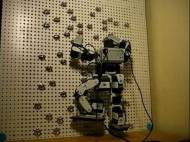Bioloid climbing robot finds its way up the climbing wall
 We already wrote about various humanoid robots capable to perform different tasks, and in this article we’re going to write about a humanoid robot which climbs up a wall with ledges. You might ask yourself what is it good for, but it (or its algorithms) could be useful for the exploring or rescuing robots in the future. Designed by Marco Wickrath, a student at the Technical University in Dortmund, Germany, the Bioloid climbing robot is able to climb its way to the top.
We already wrote about various humanoid robots capable to perform different tasks, and in this article we’re going to write about a humanoid robot which climbs up a wall with ledges. You might ask yourself what is it good for, but it (or its algorithms) could be useful for the exploring or rescuing robots in the future. Designed by Marco Wickrath, a student at the Technical University in Dortmund, Germany, the Bioloid climbing robot is able to climb its way to the top.
A Bioloid is a very powerful system from Robotis. It is basically an educational robot with many advanced features added to the newer models. The Bioloid is modular and comes in a package of powerful GUI-based software along with a very advanced hardware system and servos. The kit is user-friendly and can be used to develop different types of robots like a humanoid biped, a wheeled robot, quadruped puppy robot, spider robot or a dinosaur robot all are products of this simple kit.
The Bioloid climbing robot is a humanoid biped configuration that climbs a freely configurable wall autonomously (not a predefined motion sequence). The robot visually examines holding grips placed randomly on a pegboard and determines the best path to the top, which it memorizes. The camera used to provide the robot with information is currently not placed within the robot, but the final scenario will be a Bioloid looking at the wall using an onboard vision system.
“My part so far was developing a motion planning system which is a simulation of the real wall that calculates possible paths and developing a motion control system based on inverse kinematics so that now you can send a command like “left hand position 250/175″ and the robot is hooking its new climbing hook-hand into a grip being at this position. I made new hook-hands and climbing feet to make the robot able to climb, too”, said Wickrath.
This demonstration has 4 different target positions only and it shows the system’s accuracy even at a very high speed. This is part of an autonomous system that first looks for possible ways up a climbing wall (according to the abilities of the robot and to physical constraints) and after placing the robot at the start position of the chosen path the robots climbs up just by knowing the x/y-positions of the grips.









Leave your response!